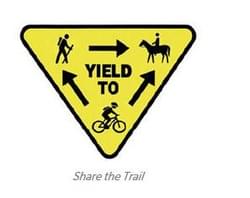




Link to Arizona State Parks & Trails
Understanding Shared-Use Trail Etiquette can make Hiking, Biking, and Riding Trails More Enjoyable for Everyone
by Arizona State Parks and Trails

If you’re headed out on one of Arizona State Parks and Trails many shared-use trails, it’s important that you understand trail etiquette — and share your knowledge with others. Good trail management combined with user education means a better time for everyone who uses Arizona’s trails. Not all trails are shared use; some are only for hikers, for example, but when you head out, please practice these principles. If you’re taking a first-timer out, whether it’s hiking, mountain biking, or horseback riding, it’s your responsibility to teach them. Someone educated you, so please pass it on.
posted Apr 17, 2024
This report summarizes guidance and best practices to create safer bicycle facilities and connect them into networks that allow more people to safely bike to more places within and throughout communities.
Setting Speed Limits for Health and Safety
posted Apr 17, 2024
This mini-report on setting speed limits shows the current framework for speed limit policies through a review of state laws that set speed limits.
posted Nov 14, 2023
These case studies reveal a number of lessons learned that will be valuable in future winter travel management planning efforts.
TRAILS SAFE PASSING PLAN: STOP, SPEAK, and STAND BACK
posted Feb 14, 2023
Horses are prey animals and naturally can be afraid of unfamiliar people and objects. Horses have natural "flight“ survival instincts and prefer to move their feet towards an exit route. Therefore, people with horses should pass at a walk while other trail users remain STOPPED until passed.
1,475 views • posted 05/30/2018